Star Trek Bridge Commander Updated Preview
We dive into an alpha build of Larry Holland and Totally Games' first entry into the Star Trek universe. Read our impressions inside.
Star Trek Bridge Commander could end up as a match made in heaven, or rather, among the stars. Here's a space sim being created by a master of the genre, set in one of the most popular science-fiction settings ever. New Star Trek games seem to appear faster than tribbles in a grain silo, each covering some aspect of the Trek universe from a different angle. There have been shooters, strategy games, adventure games, and more. Now Bridge Commander is in a position to add a new shining star to that gaming constellation by focusing on one of the highlights of the Star Trek franchise. It's a game that will put you in command of Star Trek's inspiring capital ships, letting you lead the battles right from the bridge for real control and immersion. It's not merely the approach, but rather the developer that should help set Bridge Commander apart. The game is being created by Totally Games, best known for its Star Wars X-Wing space combat games, which have become modern classics of the genre.
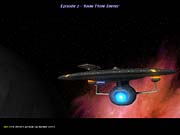
The first thing you'll notice about Bridge Commander is how much thought and effort Totally Games is putting into immersing you in the experience. From the start, the game looks and feels very cinematic and dramatic. The game opens with a brief intro movie showing a devastating catastrophe in the Vesuvi system. You're there as first officer of the USS Dauntless when the system's star explodes, destroying a colony and killing your captain, who's out in a shuttle. It's now up to you to fill the captain's shoes and get to the bottom of the mystery behind this tragic event. Needless to say, some vital clues hint that the disaster might not have been a natural one.
When the first mission begins, you'll find yourself walking onto the bridge of the Dauntless and taking the captain's chair. From there, you'll interact through a first-person perspective with your officers on the bridge, each of whom controls one of the ship's major systems. Through the ship's forward viewscreen, you'll communicate with Starfleet Command officers, ship captains, colony administrators, and other important characters.

With your ship repaired after the Vesuvi incident, you're ready to head out, but not before Captain Picard joins you on the bridge. You'll need to take this distinguished guest to speak at a symposium at another station. Along the way, he'll introduce you to your new first officer and help you learn the ropes of commanding the ship.
As you leave space dock and begin your first mission, Picard's presence works like an interactive tutorial as he offers advice and explanations. What's striking about this is how smoothly it's integrated into the early missions and how natural if feels. Instead of some dry, abstract PowerPoint-style tutorial like you find in some games, Bridge Commander offers lessons that keep you fully immersed in the fiction of being on the bridge and interacting with real people.
Taking Control
In fact, the feeling of interacting with real people will be a vital part of the whole Bridge Commander experience. All told, you'll normally have five officers on the bridge with you: first officer, helm, tactical, science, and engineering. You'll control the Dauntless by "looking" at specific officers and left-clicking to select them. They'll then turn to face you or verbally acknowledge that they're awaiting your commands. The appropriate control menus and readouts will then appear on screen, detailing the available options. If you look at an officer without selecting him or her, a small message window will temporarily appear showing what orders, if any, the officer is currently carrying out.
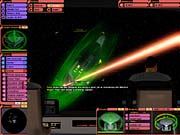
When you're ready for combat, you'll select your tactical officer and see a listing of the various ships, stations, and other objects that your scanners have picked up in the vicinity. Each is color-coded according to whether it's friendly, hostile, neutral, or of unknown status. Should an object be hostile, you can order your tactical officer to target it using the same options you've seen in the TV shows. You can either obliterate it outright or merely disable it. You can pinpoint individual subsystems, too, like the shield generators, sensor array, or power plant.
Animated readouts will detail your current weapon status, showing, for instance, the charge levels of your different phaser banks. You'll need to keep track of these so you can maneuver to take advantage of your active weapons' firing arcs. Shield status is also displayed for quick reference.
If you trust your tactical officer to get the job done himself, you can order him to fire and perform tactical maneuvers at will. If you'd like to take a more hands-on approach, you can move the targeting reticule, set phaser power levels, launch photon torpedoes, and engage tractors beams yourself. You can choose which phaser banks to fire, whether to close in on or withdraw from a target, and more.
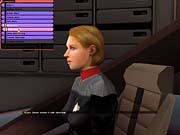
Of course, while Bridge Commander will feature a lot of dramatic ship-to-ship combat, there's more to commanding a vessel than just shooting anything that moves. Navigation, communication, exploration, analysis--all will require your attention at different times. Your first officer will act as your right hand and manage some of the most important general duties. She'll set the ship's alert levels, moving from green, to yellow, to red alert status, with shields and/or weapons powering up accordingly. Your first officer will also offer gentle reminders if you forget about your mission objectives. She'll hail Starfleet Command when you need to consult with the brass and even remind you of Starfleet regulations if you start breaking the rules.
Through your engineer, you'll get to tweak the power levels of weapons, sensors, shields, and engines for maximum efficiency. For general maneuvers outside of combat, like plotting new courses, establishing a planetary orbit, or docking at a starbase, you'll turn to your helm officer. Your science officer will launch probes and perform sensor scans.
Sweating the Small Stuff
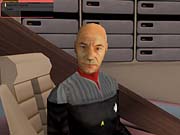
After you've learned your way around the bridge with Picard's help, he'll transfer to another ship. You'll then be able to learn the finer points of starship control on your own as your progress through the campaign. Hitting the space bar, for instance, will switch from the bridge view to an exterior one. This will not only offer a better view of the action than you'd get from the bridge, but it will also let you steer your ship directly with the keyboard. If you really want to delve into the nitty-gritty of command, you'll be able to bypass the whole bridge-officer interface and operate the control panels directly.
Whether you're playing the story-based missions, a quick battle skirmish, or one of the four or five multiplayer modes, you'll see a major emphasis on immersion. Of course, the overall design paradigm of the game, which centers you in the action on the bridge, should play a major role there. Close attention to detail should play an equally important part in conveying the full Star Trek experience. Patrick Stewart as Picard and Brent Spiner as Data lend their famous voices to the game, and the authentic sound effects should immediately sound familiar to Trek fans. The graphics look technically impressive, though it's the small things, like the bridge lights lowering when you issue a red alert, that stand out the most.
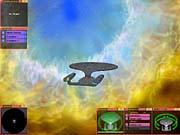
Totally Games has had full access to the Paramount archives, which should help them faithfully reproduce all the little details you've seen in the shows. And if there's one thing that puts a hard-core Trekker into a rage worse than the Vulcan Pon Farr, it's seeing a warp conduit in the wrong place. Nevertheless, Totally has had to take some liberties with its game design. On the bridge, you'll notice that the tactical officer's station has been moved from behind the captain (where it's located on the Enterprise in the Next Generation series) down to the front of the bridge. Apparently, there's a "logical" Trek universe explanation that allows this. Either way, this alteration should make the game more dramatic and involving--you won't have to keep looking over your shoulder to give firing orders. Of course, it will also be far more practical to see both the main viewscreen and your tactical officer all in the same frame at once.
While space combat will play a huge role in Bridge Commander, it's not really the ships and shoot-'em-ups that make the Star Trek universe go round. The characters, stories, and optimistic philosophy of franchise creator Gene Roddenberry are the real stars. To ensure that Bridge Commander gets the storytelling right, they've brought D.C. Fontana on board as a consultant. Fontana is probably best known for writing 10 of the original Star Trek series' episodes.
With that kind of assistance and Totally Games' track record, Bridge Commander clearly has a lot going for it from the start. If nothing else, Bridge Commander looks like it could well be one of the most immersive Star Trek games to date.
Got a news tip or want to contact us directly? Email news@gamespot.com
Join the conversation